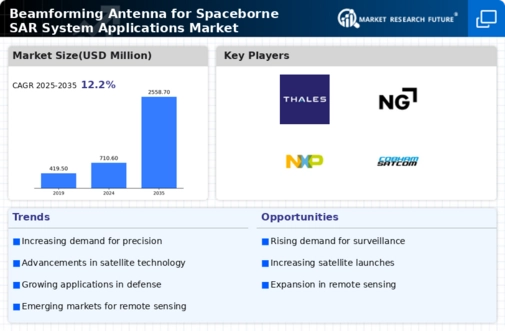By Region, the study provides market insights into North America, Europe, Asia-Pacific, Middle East & Africa, and Latin America. North America is expected to account for a market share of 36.3% in 2023 and project a growth rate of 13.4% during the forecast period. Asia-Pacific is estimated to reflect a prominent growth rate during the forecast period i.e., 14.5% reaching a value of US$ 462.7 million in 2032 from a valuation of US$ 125.2 million in 2022.
Beamforming technology is a crucial component of North America's spaceborne Synthetic Aperture Radar (SAR) systems. SAR is a remote sensing technique that uses radio waves to generate high-resolution images of the Earth's surface. The beamforming antenna in a spaceborne SAR system transmits and receives the radio waves.
Figure 2 : BEAMFORMING ANTENNA FOR SPACEBORNE SAR SYSTEM APPLICATIONS MARKET SIZE BY REGION 2022&2032

Source: Secondary Research, Primary Research, Market Research Future Database, and Analyst Review
Further, the major countries studied in the market report are the U.S., Canada, Germany, France, the UK, Italy, Spain, China, Japan, India, Australia, South Korea, Brazil and others.
The market for Europe's beamforming antennas for spaceborne SAR (synthetic aperture radar) systems specifically caters to antennas designed for these systems. Beamforming antennas are vital in SAR systems as they facilitate the transmission and reception of radar signals with exceptional precision and accuracy. These sophisticated antennas employ advanced beamforming technology to concentrate the radar beam towards specific directions, allowing SAR systems to capture highly detailed, high-resolution images of the Earth's surface.
The Asia-Pacific beamforming antenna market for spaceborne Synthetic Aperture Radar (SAR) system applications is a significant and rapidly growing market in the region. With the increasing demand for satellite-based Earth observation and remote sensing applications, the need for advanced SAR systems equipped with beamforming antennas is rising.
Asia-Pacific is experiencing significant growth in its space industry, with countries like China, India, Japan, and South Korea making notable advancements in satellite technology. These countries invest heavily in developing their spaceborne SAR capabilities to support various applications, including environmental monitoring, disaster management, agriculture, and defense. The driver behind the growth of the Asia-Pacific beamforming antenna market for spaceborne SAR applications is the increasing demand for high-resolution imaging and accurate data collection. Beamforming antennas enable SAR systems to achieve fine spatial resolution and enhanced imaging capabilities.
They allow for the precise focusing of SAR signals, resulting in improved image quality and better data interpretation.
The emerging market for beamforming antennas in the Middle East and Africa (MEA) for spaceborne synthetic aperture radar (SAR) system applications is in its early stages of development. However, the MEA region is growing interested in space technologies and their applications, including SAR systems. The increasing demand for advanced earth observation and surveillance capabilities is the main factor driving the growth of the MEA beamforming antenna market for spaceborne SAR applications. The region faces unique challenges such as environmental monitoring, natural resource management, border surveillance, and disaster response, where SAR technology can provide valuable insights and solutions.
Countries like the United Arab Emirates and Saudi Arabia have been actively investing in space programs and establishing space agencies to enhance their satellite communication, earth observation, and remote sensing capabilities. This presents opportunities for adopting SAR systems equipped with beamforming antennas.
SAR systems are used in remote sensing applications for Earth observation, environmental monitoring, disaster management, and defense. Beamforming antennas play a crucial role in SAR systems by electronically steering the radar beam to achieve high-resolution imaging and accurate data acquisition. Due to several drivers, the Latin American market for beamforming antennas in spaceborne SAR applications has grown. The increasing need for advanced SAR systems in Latin America to address various environmental challenges, such as deforestation monitoring, land use mapping, and coastal erosion, is driving the demand for beamforming antennas.
Secondly, the growing emphasis on national security and defense capabilities in the region fuels the adoption of spaceborne SAR systems, thereby creating a demand for beamforming antennas. Additionally, the rising investments in space research and development by Latin American countries contribute to market growth.
Recent Development News : Beamforming Antenna for Spaceborne SAR System Applications Market
August 2023 saw Leonardo work with Altair, which is a global leader in data analytics and simulation, to assist in the design of a helicopter radar antenna through the use of digital twin technology. From this partnership, it has been possible to develop a digital twin of the structural and electromagnetic systems of the radar antenna. This digital twin enables the Leonardo DRS to monitor the deformations of the radar antenna design and the electrical changes that are induced by the in-flight conditions.
This data can then be applied in making more regions of future antenna systems with maximum efficiency and minimum costs attributable to prototypes.
On Mars 2023, Navarino and Cobham Satcom, a leader in satellite communication (satcom) solutions for the maritime and land mobile sectors, have augmented their strategic cooperation by further integrating Cobham Satcom's next-generation SAILOR XTR antennas into Navarino's global connectivity services.
Thales Group announced the development of a new antenna using metamaterials specifically for spaceborne SAR systems in 2020. The new antenna is said to improve performance compared to conventional antennas significantly.
In 2021, Northrop Grumman was able to reveal a novel phased array antenna suitable for spaceborne SAR systems. As claimed, this new antenna is the smallest and lightest phased array ever created.
















Leave a Comment